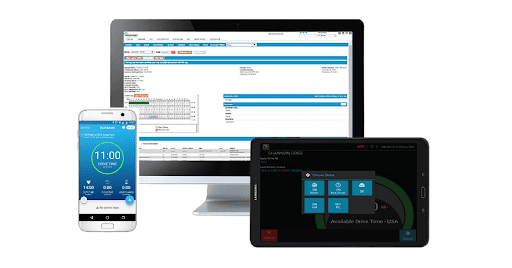Truckers cover a lot of ground over the course of their shifts, and all that time spent on the road can cause significant wear to the truck. As such, drivers and owner-operators use engine hours to track truck performance, as well as maintenance, which can ensure that drivers take the breaks they not only deserve but also need.
Engine hours are simply a count of how many hours a truck’s engine runs per day, week or other timeframe. Companies can then use this data to ensure that the truck receives the maintenance it requires for reasonably priced services.
Companies track engine hours for many reasons. Most of all, tracking engine hours is a priority because doing so can lead to healthier trucks and more efficient business practices.
How Do Engine Hours Work?
Engine hours refer to the period of time during which a truck’s engine is turned on and actively running. This includes time on the road as well as idle time. Engine hours are typically tracked alongside mileage, though the numbers may differ if a truck spends a lot of time idling.
Truckers track engine hours using an ELD, which is short for electronic logging device. They are installed directly into the truck, at which point they track the number of hours the truck’s engine is running.
Most ELDs require you to pay a monthly subscription fee as well. The engine hours are stored on an ELOG, an electronic version of a truck log. This data helps owner-operators keep track of their drivers and monitor the health of their trucks.
Are Truckers Required To Track Engine Hours?
In addition to engine hours providing valuable insight, many trucking companies are required by the FMCSA to track engine hours. In addition, any company required to maintain records of duty status (RODS) must also use ELDs to track their engine hours.
Engine hours must be paid attention to because doing so leads to safer roads, seeing as engine hours data can provide insight into when trucks need to undergo preventative maintenance. This can include fuel filter replacements, oil changes and more.
ELDs are required in most commercial trucks. They keep track of the hours your engine is running and then store that information in an ELOG. Owner-operators can then review this data and see what maintenance needs to be done while also learning how they can cut down on idling time.
How Engine Hours Can Help With Efficiency
In short, tracking engine hours can save money and make your business more efficient. Proactive maintenance is always cheaper than repairing a truck that has already broken down, rendering it unusable.
By monitoring engine hours, you’ll be able to perform preventative maintenance on time before it begins to damage the truck. This can save you money because you won’t have to pay for repairs, and you’ll also get to extend the lifespan of your fleet as well.
Engine hours can also show you how much time your truck spends idling. While idling may not seem like a big deal, it burns a lot of fuel, releases unnecessary emissions and causes wear to your vehicle. Engine hours may be able to provide insight on how to cut down on idling time to preserve your truck and save money on fuel as well as maintenance.
Your engine needs to be turned on, even when the truck isn’t in motion. If you set rates based on miles, it might not be accurate due to the time spent idling. But if you consider engine hours when setting rates, you’ll be able to bill more accurately and ensure you’re making the right amount of money compared to your work.
Some warranties require companies to track engine hours. So, don’t waste your precious warranty hours with idling. You’ll know whether you’re still under warranty by monitoring engine hours.
What To Consider With Engine Hours
Engine hours can help you identify ways to save money and increase efficiency, but there are also a few things to remember when looking at the hours in your truck log.
Engine Hours vs Mileage
Engine hours are a great way to gain insight into your truck’s health, but you shouldn’t only rely on engine hours. Tracking mileage is typically required by the IFTA and can also help you know when maintenance is needed. Idling will not cause as much wear and tear as driving will, so it’s important to consider both when planning maintenance.
Idling Time
Your drivers might not cover many miles while idling, but idling still wears on the engine in addition to burning fuel. Engine hours can show you when there are too many unnecessary hours spent idling as well.
Owner-operators can use this data to communicate with their drivers and let their drivers know what an acceptable idling period looks like. They can also set guidelines for idling and enforce them by monitoring the ELOG. This will lower their fuel costs while allowing trucks to be in operation longer with less need for maintenance.
Accurate Engine Logs
Engine hours won’t tell you much if the data points aren’t correct. Therefore, you should regularly check your ELD device to ensure it is working properly and receives services to fix it as necessary.
Also, check to ensure that your ELDs are up to date in terms of software updates. Keep them properly installed in the truck as well.
It’s also important to pick the right ELD device for your fleet. You’ll want to ensure the ELD you select is in compliance with ELD requirements and offers crucial features, like GPS tracking, report fuel consumption and IFTA tracking.
Save Money Tracking Engine Hours
The goal of any business is to find ways to make operations more efficient, seeing as time is money. Engine hours can keep your trucks running smoothly, preventing you from having to pay for expensive emergency repairs.
Tracking them can also help you extend your truck’s lifespan since it will be under supervision and receive necessary maintenance as a result. Additionally, engine hours can help you bill people more accurately, ensuring that you receive every cent you deserve.
Investing in a good ELD device is not only mandatory by the FMCSA, but doing so can also help your business cut costs, meaning more of your earnings will be profits rather than expenses. That way, you will have more capital, which you can allocate towards bettering and growing your business.
FAQ
ELD devices became mandatory in most trucks in 2019. The ELD devices track engine hours and send them to ELOGs.
All ELD devices are slightly different, but many of them track engine hours, mileage and fuel consumption while monitoring the overall health of the engine.
Typically, drivers cannot drive for longer than 14 hours at a time. The short-haul exception allows drivers to operate their vehicles for more than 14 hours at a time if they stay within a 150-mile air radius.


